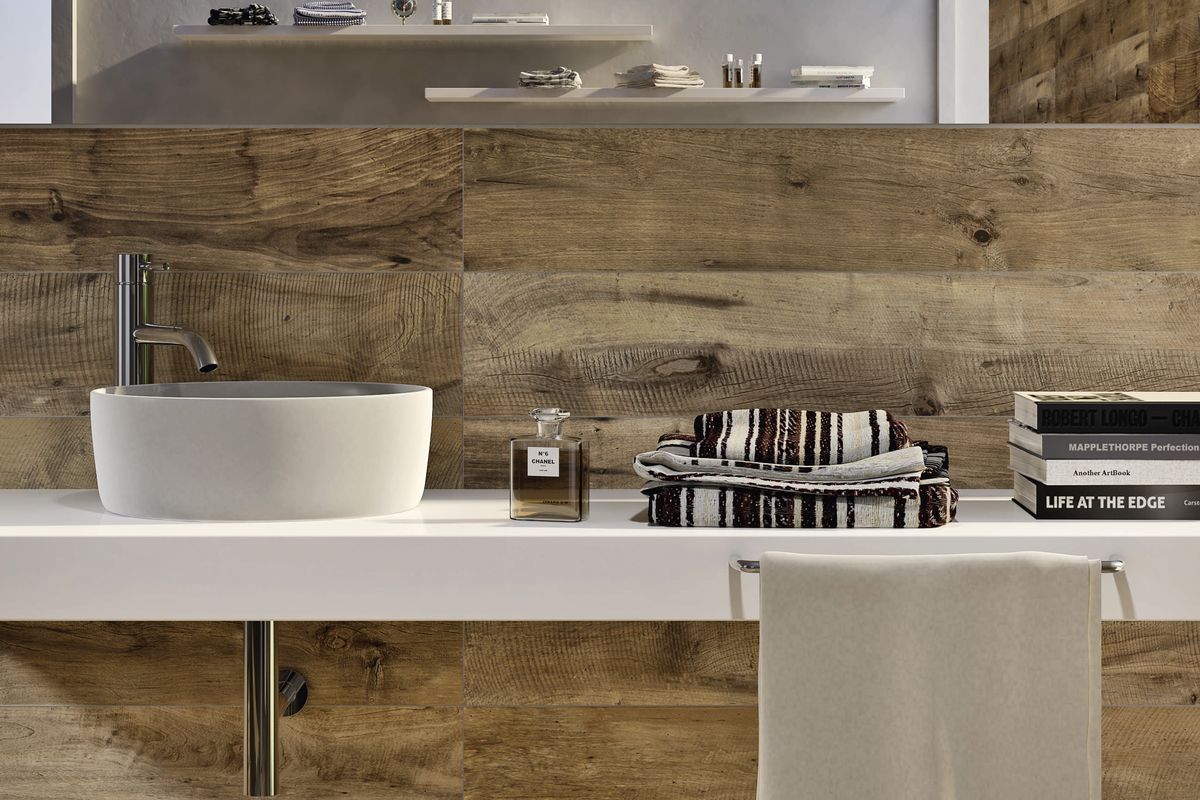Faux finishes, unexpected shapes and motifs elevate tile beyond sterile ceramic

Tile has a rich and varied history in decor, from Roman floor mosaics to majolica to Delft ceramics to Mexican terracotta.
These styles and more continue to inspire artistry. Many of the newest collections of ceramic and porcelain tile were on display this fall at the five-day Cersaie international exhibition in Bologna, Italy.
Some of the trends:
Master impostors
Across the show, faux finishes ruled. What seemed to be barnwood or other timber planking was actually porcelain. Manufacturers can now produce tile that looks – and even feels – like wood, marble, granite or cement, but is thin and lightweight.
The advantages are obvious: A 20-foot slab of slim porcelain printed to look like stone is a lot easier to make and install than the real thing. It can be wrapped up kitchen islands, walls and even ceilings, and is easily cut to accommodate plugs or faucets.
Advancements in digital printing have taken faux finishes a long way from earlier versions. Now the detail is more precise, the image is embedded deep in the tile, and the surface texture is transformed.
The Reclamation collection from Crossville, based in Crossville, Tennessee, is comprised of an urban-industrial mix of cement and tiles that look like salvaged wood in colorways with names like Steel City, Cotton Exchange and Tobacco Road. (www.crossvilleinc.com)
Serenissima Cir, based in Casalgrande, Italy, used a palette of brick from Prohibition-era Chicago to create a tile collection that looks and feels time-worn, right down to the original maker’s “Chicago” stamp. (www.cir.it)
Metallic glazes are also evolving. You’ll see patterns with a subtle brush of coppery glitter, while others have dramatic gold, copper and silver finishes. Antiquing gives mirrored tiles a mercury-glass quality.
Unusual sizes
Tile has typically come in squares and rectangles measuring between 4 inches and 12 inches. But larger versions up to 24 or even 36 inches are now available, and the faux-wood ones resemble planks.
Dwell Patterns has collaborated with Heath Ceramics, of Sausalito, California, on a hip-looking collection that incorporates diamond and hexagonal shapes, available in glossy or matte finishes in a broad color palette. (www.heathceramics.com)
At Cersaie, hexagons and triangles small and large were shown in earthy hues like mocha, mud and charcoal. Unica by Target Studio’s Origami collection added subtle textural patterns to tone-on-tone black, white or gray tile in shapes evoking the artistry of Japanese paper folding. (www.targetstudio.net)
Ragno offers an intriguing way to use its Rewind hexagonal tile and Woodplace faux wood; they join seamlessly in a way that would be impossible with ordinary tile and real wood.
Mirage’s XGone series of hexagonal tiles designed by Javier Deferrari and Lavinia Modesti includes some that are notched to connect to others; the resulting pattern, in an array of complementary tonal hues, has a modern-art vibe. (www.mirage.it)
Old World and vintage
Neoclassical and Oriental tapestry and lace patterns turned tile into elegant wallpaper in the Onice and Wallpaper collections at the Marazzi booth. (www.marazziusa.com) The company also showed an oversize vintage floral in a new way, as a ceiling-to-floor accent on an otherwise solid-color wall, again evoking paper or fabric wallcovering.
Ancient Mediterranean motifs printed on matte-finish tile in faded, organic hues bridge the centuries. Panaria’s Memory collection recalls Provencal paver patterns of the late 1800s. And Tagina’s Terre Nostre collection echoes the pavers of Umbrian medieval villages. You can find similar, smaller-scale versions at www.cementtileshop.com.
Ceramica Bardelli featured the work of London designer Robert Dawson. He took the classic Willow porcelain design, deconstructed its chinoiserie elements and printed them on large-scale tiles. The effect is as if an enormous china plate had been shattered, then affixed to the wall. (www.bardelli.it)
Tile as art canvas
Ascot has launched Game of Fifteen, a series of tile designs honoring contemporary art. Keith Haring’s radiant baby and running figures pack graphic punch in black on glazed white ceramic. (www.ascot.it)
ABK’s Do Up collection includes an image of a contemporary geisha and tiles printed with faux-spray-painted graffiti a la Banksy. (www.abk.it)
In a collection called Portland 325, ABK’s Ariana group took inspiration from the walls of an abandoned factory, transforming graffiti into elegant art tiles with iridescent finishes.
Sicis showed the possibilities of mosaics by creating wall panels embedded with butterflies, stars and flowers. The vibrant reds, blues and golds were achieved with minerals like copper and lapis. (www.sicis.com)
Scottish wallpaper studio Timorous Beasties is moving into tile design through the tile studio Cle, in Sausalito. Medieval damask motifs are combined with ink-blot patterns to create stylized designs that are hand-lithographed onto limestone and marble tiles. Cle showcases several innovative tile artists in its online shop. (www.cletile.com)
Finally, at Modwalls, you’ll find mosaic tile made of sliced, recycled wine corks, and pennies. Here, too, is a paint box full of hues in glass subway tiles, including orange, lemongrass, pool blue and poppy. (www.modwalls.com)